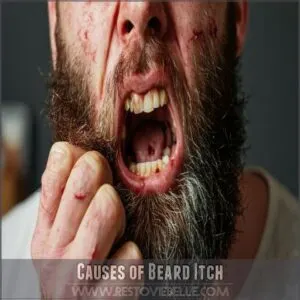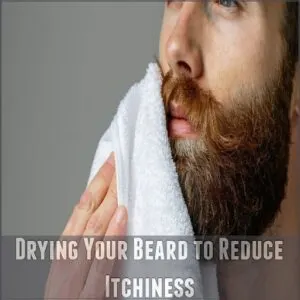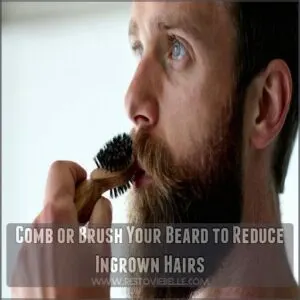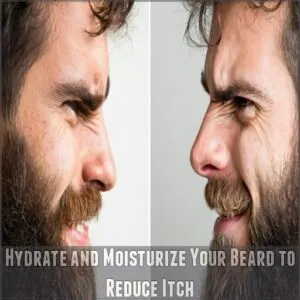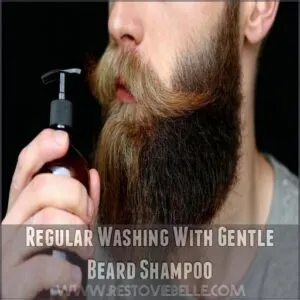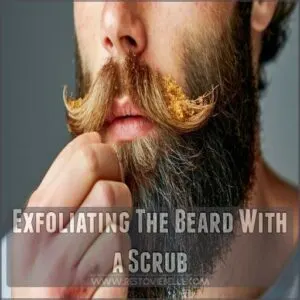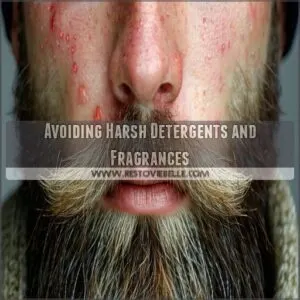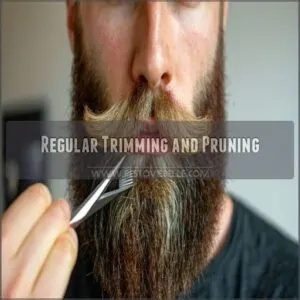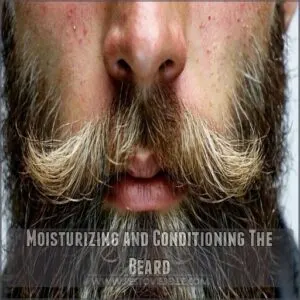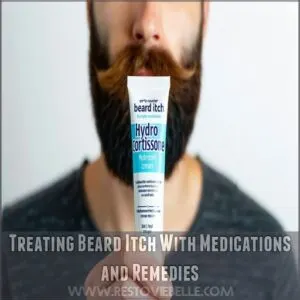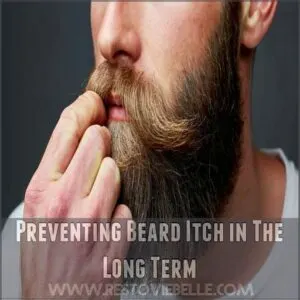This site is supported by our readers. We may earn a commission, at no cost to you, if you purchase through links.
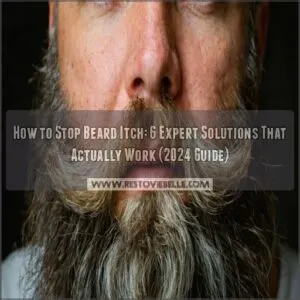 Got that beard driving you nuts? You can stop beard itch by following a simple routine that’ll transform your facial forest from scratchy to smooth.
Got that beard driving you nuts? You can stop beard itch by following a simple routine that’ll transform your facial forest from scratchy to smooth.
Start with daily cleansing using a gentle beard wash, then pat dry thoroughly – no vigorous rubbing! Apply beard oil to moisturize both the hair and skin underneath, and use a boar bristle brush to distribute it evenly.
Keep your beard trimmed regularly to prevent split ends, and always use sharp, clean tools.
For stubborn itch, try tea tree oil or aloe vera gel.
But there’s more to maintaining a magnificent mane than meets the eye.
Table Of Contents
- Key Takeaways
- Causes of Beard Itch
- How to Stop Beard Itch
- Cleaning and Maintaining a Beard
- Moisturizing and Conditioning The Beard
- Treating Beard Itch With Medications and Remedies
- Preventing Beard Itch in The Long Term
- Frequently Asked Questions (FAQs)
- How to get rid of beard itch?
- What can I do for an itch that has suddenly become unbearable?
- How do you keep a beard dry & itchy?
- How to keep a beard Itch at arm’s length?
- How do you treat an itchy beard rash?
- How long does it take for a beard to stop itching?
- How do I get my beard to stop itching?
- How long does new beard itch last?
- How to make a beard less scratchy?
- How to stop itching when hair is growing?
- How long does beard itch typically last?
- Can certain foods trigger beard itch?
- Should I trim my beard to reduce itching?
- Does beard itch mean Im allergic to facial hair?
- Can stress or hormones cause beard itching?
- Conclusion
Key Takeaways
- Keep your beard clean by washing it 2-3 times weekly with a gentle beard shampoo and pat dry with a microfiber towel – avoid harsh soaps that strip natural oils.
- Apply beard oil daily after washing to moisturize both the hair and skin underneath, then use a boar bristle brush to distribute oils evenly and prevent ingrown hairs.
- Watch for signs of infection like unusual redness, swelling, or persistent itching – if basic care doesn’t help after 2-3 weeks, consult a dermatologist.
- Stick to fragrance-free products with natural ingredients like jojoba oil, aloe vera, and tea tree oil to minimize irritation and allergens that can trigger itching.
Causes of Beard Itch
You’re not alone if your beard feels like it’s hosting a scratching contest, as everything from dry skin to sneaky ingrown hairs, which can be caused by curly hair and shaving, can turn your facial masterpiece into an itchy nightmare.
While growing a beard might seem straightforward, there’s actually a bunch of surprising culprits that can make your face feel like it’s been attacked by invisible mosquitoes, from fungal infections to that dreaded beard dandruff.
Dry Skin Under The Beard
That itchy beard driving you crazy? Dry skin under your facial hair is often the culprit.
Think of your beard like a canopy that traps moisture and creates the perfect environment for irritation.
Here’s what usually causes that dreaded desert-dry feeling:
- Cold weather stripping away natural oils
- Over-washing with harsh products
- Lack of proper moisturizing routine
- Poor diet lacking essential nutrients
Ingrown Hairs and Folliculitis
When those pesky beard hairs curl back into your skin, they can trigger an inflammatory response called folliculitis.
You’ll notice small, red bumps that feel tender and itchy.
It’s like your facial hair is throwing a tiny rebellion!
The main culprits? Tight curls, dead skin buildup, and bacteria getting trapped in the follicles.
Regular exfoliation and proper beard care can help keep these troublemakers at bay.
Razor Burn and Pseudofolliculitis Barbae
Razor burn and pseudofolliculitis barbae can turn your beard journey into a painful experience.
Just like ingrown hairs, these conditions strike when hair follicles get irritated from shaving too close or using dull razors.
You’ll notice red bumps, burning sensations, and itching right after shaving.
Applying a product like a razor burn balm can provide immediate relief.
To avoid this, always use sharp razors, shave with the grain, and apply a soothing aftershave balm.
Seborrheic Dermatitis and Beard Dandruff
Beard dandruff and seborrheic dermatitis can turn your majestic mane into a flaky mess.
This common condition causes red, scaly patches and intense itching under your beard.
Here’s what to watch for:
- Yellowish-white flakes that stick to beard hair
- Reddish, inflamed skin patches
- Greasy or oily areas in your beard
- Persistent itching that worsens with stress
- A burning or tight sensation when moving your face
Tinea Barbae and Fungal Infections
Occasionally, that persistent beard itch might be more than just dry skin – you’re dealing with tinea barbae, a fungal infection that loves to party in your facial hair.
Think of it as athlete’s foot for your beard (gross, right?).
You’ll notice red, scaly patches, hair loss, and intense itching.
Don’t try to tough it out – this fungal troublemaker needs proper antifungal treatment from your doctor.
Staph Infections and Bacterial Conditions
While fungal problems can be tricky, bacterial infections like staph are a whole different beast.
You’ll notice small, painful red bumps that might ooze or crust over – that’s your cue to see a doctor ASAP.
Unlike regular beard itch, staph infections need prescription antibiotics to clear up.
Don’t try to tough it out with home remedies; these infections can spread fast and turn serious.
How to Stop Beard Itch
You don’t have to suffer through the dreaded beard itch that’s turning your facial hair journey into a scratchy nightmare.
Whether you’re dealing with a stubborn case of beardruff or just starting your growth journey, these proven solutions will help you kick that irritating itch to the curb and get back to rocking your beard with confidence.
Start With a Clean Slate and Proper Hygiene
Starting your beard care journey with proper hygiene is like hitting the reset button on that maddening itch.
You’ll want to wash your facial hair 2-3 times weekly with a gentle beard-specific cleanser – regular shampoo’s too harsh and strips away natural oils.
Between washes, use a clean boar bristle brush to remove dead skin cells and distribute oils evenly throughout your beard.
Drying Your Beard to Reduce Itchiness
Drying your beard properly is a game-changer for fighting that annoying itch.
Instead of rough towel rubbing, gently pat your facial hair with a clean microfiber towel to prevent irritation.
If you’re in a rush, blot the excess water and let it air dry naturally.
For extra comfort, use a cotton t-shirt instead of a regular towel – it’s gentler on your facial hair and skin.
Remember that proper beard care can help reduce itchiness by keeping your skin and beard healthy.
Comb or Brush Your Beard to Reduce Ingrown Hairs
Establishing a clear neckline is key, see how to trim a neck beard for a precise definition, especially above the Adam’s apple. Combat those pesky ingrown hairs with a daily beard grooming routine that’ll make your face feel like a million bucks.
Here’s what regular brushing and combing does for you:
- Trains stubborn hairs to grow in the right direction
- Removes trapped dirt and dead skin cells
- Stimulates blood flow to your facial follicles
- Distributes your skin’s natural oils evenly
Pro tip: Use a boar bristle brush in the morning and a wide-toothed comb before bed.
Hydrate and Moisturize Your Beard to Reduce Itch
Now that your beard is tangle-free, let’s get that moisture game on point.
Your facial hair needs hydration like a plant needs water.
Here’s a quick guide to keeping your beard happy and itch-free:
| Product Type | Benefits | Best Time to Apply |
|---|---|---|
| Beard Oil | Softens hair, moisturizes skin | After shower |
| Beard Balm | Holds shape, conditions | Morning styling |
| Natural Butter | Deep conditioning, overnight repair | Before bed |
| Face Moisturizer | Prevents dryness, reduces flaking | Morning and night |
Pro tip: Massage products in circular motions to stimulate blood flow and distribute evenly.
Problem Beard Itch That Doesn’t Go Away
Sometimes beard itch sticks around despite your best efforts.
When you’ve tried everything and that annoying itch won’t quit, it’s time to think about these deeper issues:
- Hidden skin allergies to your favorite products
- Underlying conditions like seborrheic dermatitis
- Stubborn cases of pseudofolliculitis barbae
- Persistent tinea barbae infections
Book that dermatologist appointment – they’re pros at pinpointing what’s really bugging your beard.
Cleaning and Maintaining a Beard
You’ll find that keeping your beard clean isn’t rocket science, but it’s the secret weapon against that maddening itch that’s been driving you crazy.
Just like you wouldn’t skip washing your hair, your beard needs regular TLC with the right products and techniques to stay itch-free and looking sharp.
Regular Washing With Gentle Beard Shampoo
Washing your beard correctly makes the difference between a scratchy mess and a glorious mane.
Your regular hair shampoo won’t cut it – you need a gentle beard wash that won’t strip away natural oils.
| Washing Schedule | Benefits | Best Practice |
|---|---|---|
| Daily | Fresh feel | Quick rinse only |
| 2-3 times/week | Deep clean | Use beard shampoo |
| Weekly | Maintenance | Oil after wash |
You’ll want to work the shampoo into your beard with your fingertips, making sure you reach the skin underneath.
Exfoliating The Beard With a Scrub
Regular cleansing isn’t enough to keep your beard game strong.
A good scrub twice a week helps kick dead skin cells to the curb and prevents those pesky ingrown hairs.
You’ve got options: store-bought beard scrubs work great, or whip up your own with coffee grounds and coconut oil.
Just use gentle circular motions – no need to go full Gordon Ramsay on your face.
Drying The Beard Thoroughly With a Towel
Most guys make the rookie mistake of roughly rubbing their beard dry, but that’s a fast track to irritation.
Instead, pat your beard gently with a soft microfiber towel until it’s just slightly damp.
Here are three pro tips for proper beard drying:
- Use dabbing motions instead of rubbing to prevent tangles
- Start from the roots and work your way down
- Let it air dry the rest of the way naturally
Avoiding Harsh Detergents and Fragrances
Your beard deserves better than harsh chemicals that strip away natural oils.
While drying properly matters, what you put on your beard makes a huge difference.
Here’s a quick guide to keeping your facial forest happy:
| Ingredient Type | What to Avoid | Natural Alternative |
|---|---|---|
| Cleansers | Sulfates (SLS) | Castile soap |
| Fragrances | Artificial scents | Essential oils |
| Preservatives | Parabens | Tea tree oil |
| Alcohols | Denatured alcohol | Aloe vera |
Stick to gentle, fragrance-free products that work with your skin’s natural chemistry, not against it.
Regular Trimming and Pruning
While gentle products keep your beard healthy, smart trimming takes it to the next level.
Keeping those ends neat prevents split ends that can trigger itching and irritation.
For a perfectly shaped beard, consider following a guide on how to trim a big beard.
Think of it like giving your beard a fresh haircut every few weeks – use quality beard scissors or a trimmer to shape and maintain your desired length.
Plus, regular pruning helps distribute natural oils more evenly throughout your facial hair.
Moisturizing and Conditioning The Beard
You wouldn’t let your favorite plant go thirsty, so don’t let your beard suffer from dryness that’ll make you scratch like a bear with poison ivy.
A proper moisturizing routine with the right beard oils and conditioners will transform your scratchy facial forest into a soft, manageable masterpiece that’ll make even your barber proud.
Applying Beard Oil for Softening and Hydration
Now that you’ve got your beard squeaky clean, let’s tackle the secret weapon against beard itch – beard oil.
Think of it as nature’s moisturizer for your facial forest.
Here’s how to make the most of it:
- Apply 3-4 drops of oil to your palm, then work it through damp beard hair
- Massage the oil deep into your skin using circular motions
- Pay extra attention to patchy or extra-itchy spots
Using a Beard Conditioner for Softening and Detangling
Beyond beard oil‘s magic, a good beard conditioner is like sending your facial hair to a spa day.
It smooths out those stubborn tangles and keeps your beard soft as silk.
Here’s what you need to know:
| Conditioner Type | Best For | Key Benefits |
|---|---|---|
| Leave-in | Daily use | All-day moisture |
| Rinse-out | Deep treatment | Intense repair |
| Balm-style | Styling control | Hold + moisture |
| Natural butter | Sensitive skin | Gentle care |
| Co-wash | Regular cleansing | Cleanses + conditions |
Apply conditioner after washing, working it through your beard with a wide-toothed comb.
Let it sit for 2-3 minutes before rinsing.
Applying a Facial Moisturizer for Hydration
Your beard conditioning routine isn’t complete without a good facial moisturizer.
Think of it as giving your skin the hydration it craves after a long day.
Here’s what proper moisturizing can do for you:
- Locks in moisture right after washing
- Creates a protective barrier against environmental stress
- Reduces flaking and beard dandruff
- Helps prevent that annoying beard itch during growth phases
Apply your moisturizer right after washing, gently massaging it into your skin beneath your beard.
Remember, happy skin equals a happy beard.
Natural Moisturizers for Beard Care
Looking for affordable beard care solutions right in your kitchen?
Mother Nature’s got your back with powerful natural moisturizers.
Olive oil works wonders as a deep conditioner, while for treating razor bumps, natural remedies like aloe vera can be very effective in soothing irritated skin, aloe vera soothes irritated skin.
Try massaging in some coconut oil before bed, or whip up a quick DIY beard balm with shea butter and beeswax.
Even cucumber slices can provide instant relief from that stubborn itch.
Choosing Products With Natural Ingredients
Natural ingredients shine for beard care.
While off-the-shelf options work well, scanning those ingredient labels is worth your time.
Skip anything packed with synthetic fragrances, parabens, or sulfates – they’re like party crashers at your beard’s moisturizing bash.
Instead, grab products featuring jojoba oil, shea butter, or vitamin E.
These gentle heroes keep your facial forest happy without triggering reactions or irritation.
Treating Beard Itch With Medications and Remedies
If you’ve tried every beard oil and brush in your bathroom cabinet but still can’t shake that persistent itch, it’s time to bring out the big guns with targeted medications and remedies.
From over-the-counter creams to prescription treatments, you’ll find relief options that pack more punch than your standard beard care routine.
Medicated Ointments and Creams for Dry Skin and Folliculitis
While beard oils work wonders, sometimes you need the extra power of medicated treatments.
Over-the-counter options like hydrocortisone cream can quickly calm that maddening itch and reduce inflammation.
Here’s what works best for different beard issues:
- 1% hydrocortisone cream tackles mild inflammation and itching
- Antifungal creams fight off stubborn fungal infections
- Tea tree oil-based ointments combat bacterial growth
- Salicylic acid treats flaky, scaly patches
- Benzoyl peroxide helps clear up folliculitis
For persistent symptoms, talk to your dermatologist about prescription-strength anti-inflammatory ointments.
Oral Medications for Severe Conditions
When severe beard itch persists despite topical treatments, your doctor may prescribe oral medications to tackle the underlying cause.
For fungal issues, you can also explore over-the-counter antifungal beard itch products.
Antibiotics can clear bacterial infections, while antifungals combat stubborn fungal issues like tinea barbae.
For inflammatory conditions, oral steroids provide quick relief, and antihistamines help with allergic reactions.
Just remember, these powerful prescriptions should only be used under medical supervision.
Laser Hair Removal for Chronic Conditions
For guys battling persistent beard issues, laser hair removal might be your ticket to freedom from constant irritation. This permanent solution targets problematic areas with precision, though it’s not cheap.
- Reducing ingrown hairs can be achieved through various techniques, including mastering gentle hair removal techniques to prevent razor bumps and preventing razor burn. Reduced ingrown hairs by up to 90% after 6-8 sessions
- Decreased inflammation and razor bumps considerably
- Lower maintenance costs in the long run
- Permanent relief from chronic beard-related skin conditions
Consider this investment if you’re tired of daily beard battles.
Natural Remedies for Beard Itch Relief
Looking to tame your beard’s rebellious itch naturally?
Nature’s medicine cabinet offers powerful solutions.
Tea tree oil’s antimicrobial properties can soothe irritated skin, while aloe vera provides cooling relief.
Mix coconut oil with a drop of tea tree oil for a potent anti-itch blend.
For sensitive skin, try an oatmeal paste or diluted apple cider vinegar – both work wonders to calm beard-related irritation.
Home Remedies for Itchy Beard
Several powerful home remedies can banish beard itch without breaking the bank.
Using a sharp razor and shaving with the grain can help prevent razor burn and bumps, a common cause of itchiness learn how to stop itching after shaving. Mix aloe vera with tea tree oil for a soothing combo that calms irritated skin.
Try a coconut oil massage before bed – it works wonders overnight.
For stubborn itch, whip up an oatmeal mask or dab on some honey mixed with lemon juice.
These kitchen-cabinet fixes deliver quick relief when your beard’s acting up.
Preventing Beard Itch in The Long Term
You’ll be glad to know that keeping your beard itch-free isn’t just about quick fixes – it’s about building habits that last.
Think of your beard as a long-term investment: with the right daily care routine and smart product choices, you can stop that pesky itch before it even starts.
Early Treatment and Prevention of Infections
Catching beard infections early can save you from weeks of discomfort.
Watch for red flags like unusual redness, swelling, or persistent itching that doesn’t improve with regular care.
If you spot these signs, clean the area with a gentle antiseptic soap and apply an over-the-counter antibiotic cream.
Natural remedies like tea tree oil can help too, but don’t hesitate to see a doctor if symptoms persist.
Long-Term Management of Conditions
After treating any infections, staying itch-free requires a smart long-term strategy.
Think of it like maintaining a car – regular care keeps everything running smoothly.
Here’s your game plan for lasting beard comfort:
- Track your skin’s reactions to different products in a beard journal
- Balance your diet with biotin and omega-3 rich foods
- Get 7-8 hours of quality sleep to support skin repair
- Consider allergy testing if sensitivity persists
Regular Hygiene Practices to Reduce Itch
Maintaining a solid beard hygiene routine isn’t rocket science – it’s all about consistency.
Start your day with a gentle beard wash using lukewarm water and specialized beard shampoo.
Every other day, use a boar bristle brush to exfoliate and distribute natural oils.
Pat dry with a clean microfiber towel, and remember: your beard’s like a pet – treat it right, and it’ll behave.
Avoiding Irritants and Allergens to Reduce Itch
To keep your beard itch-free, you’ll need to play detective with potential irritants.
Common triggers include fragranced products, harsh chemicals in soaps, and even your favorite cologne.
Consider using fragrance-free beard oil as a gentle alternative to your regular products.
Switch to fragrance-free beard products and patch test new items on your inner arm first.
Stick to natural ingredients like jojoba oil and aloe vera, which rarely cause reactions.
Your skin will thank you for being extra picky!
Consulting a Doctor for Persistent Itch
Despite your best efforts with beard care, sometimes that stubborn itch just won’t quit, especially if you’re dealing with conditions like seborrheic dermatitis or fungal beard care.
Here’s when it’s time to book that doctor’s appointment:
- Itch persists beyond 2-3 weeks of consistent care
- You notice red, inflamed, or scaling skin
- There’s unusual hair loss or patchy growth
- You experience severe pain or burning sensations
- You develop fever or swollen lymph nodes
Skip the self-diagnosis rabbit hole – a dermatologist can pinpoint the real issue and get you back to beard bliss.
Frequently Asked Questions (FAQs)
How to get rid of beard itch?
Nearly 85% of men face beard itch during growth.
You’ll beat the scratch by washing with beard shampoo 2-3 times weekly, applying beard oil daily, using a boar bristle brush, and keeping skin moisturized with jojoba-based products.
What can I do for an itch that has suddenly become unbearable?
Apply ice-cold compress for instant relief, then massage in beard oil with jojoba.
You’ll want to use a boar bristle brush to exfoliate, followed by a moisturizer like Nivea Soft containing jojoba oil.
How do you keep a beard dry & itchy?
Regular washing with beard shampoo, followed by thorough drying and moisturizing with beard oil, keeps your facial hair hydrated and itch-free.
Don’t forget to exfoliate and use a boar bristle brush daily.
How to keep a beard Itch at arm’s length?
Did you know 75% of men experience beard itch?
Keep yours tame by washing with gentle beard shampoo, using jojoba oil daily, and brushing with a boar bristle brush.
Don’t forget to hydrate inside and out!
How do you treat an itchy beard rash?
Wash your beard with gentle shampoo, then pat dry.
Beard oil with jojoba to soothe skin, and apply moisturizer daily.
For serious rashes, try an over-the-counter hydrocortisone cream for quick relief.
How long does it take for a beard to stop itching?
That scratchy feeling typically lasts 2-4 weeks while your skin adjusts to new growth. You’ll notice improvement around week 3, especially if you’re using beard oil and maintaining good hygiene habits.
How do I get my beard to stop itching?
Keep your beard moisturized with beard oil and gentle shampoo.
Brush regularly with a boar bristle brush to exfoliate.
Don’t overwash, and maintain a healthy diet rich in essential nutrients for the best beard health.
How long does new beard itch last?
Beard itch typically peaks around week 2-3 of growth and lasts 2-4 weeks total.
You’ll notice it easing up once your facial hair softens and your skin adapts to the new growth pattern.
How to make a beard less scratchy?
Mastering that rugged look doesn’t mean feeling like sandpaper.
Use beard oil daily, regularly condition with a quality balm, and brush with boar bristles.
You’ll transform your prickly mane into touchable silk.
How to stop itching when hair is growing?
Apply beard oil daily and gently exfoliate with a soft brush to reduce itching.
You’ll also want to keep your face moisturized, wash with mild shampoo, and use a conditioner specifically designed for facial hair.
How long does beard itch typically last?
You’ll typically experience beard itch for 2-4 weeks during the initial growth phase.
It’s most intense around week two when new hair tips are sharp, but don’t worry – it’s temporary and manageable.
Can certain foods trigger beard itch?
While most foods won’t directly cause beard itch, low intake of vitamins A, B, C, and E can make your facial hair brittle and itchy.
Fish, eggs, nuts, and leafy greens help maintain healthy beard growth.
Should I trim my beard to reduce itching?
Trimming your beard can help reduce itching by removing split ends and damaged hair that often cause irritation.
Trimming keeps your facial hair healthy and itch-free.
Does beard itch mean Im allergic to facial hair?
That itchy feeling isn’t an allergy – it’s just your facial skin adjusting to new growth.
Your beard isn’t betraying you, but your skin needs extra TLC during the growing phase.
Can stress or hormones cause beard itching?
Yes, stress and hormonal changes can trigger increased sebum production and skin inflammation, causing your beard to itch.
Managing stress through relaxation techniques and maintaining hormonal balance with a healthy lifestyle can help reduce itching.
Conclusion
Mastering how to stop beard itch isn’t rocket science – it’s all about consistency and care.
Whether you’re rocking a full beard or just starting your growth journey, remember that proper cleaning, moisturizing, and maintenance are your best friends.
Got persistent itch? Don’t tough it out. Try the solutions we’ve covered, from gentle washing to targeted treatments, and if the problem persists, check in with a dermatologist.
Your dream of a comfortable, itch-free beard is totally achievable.
